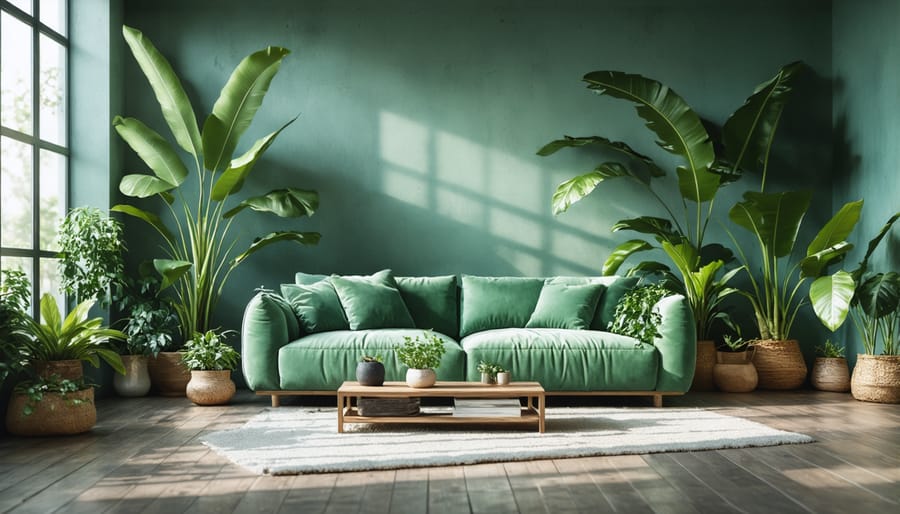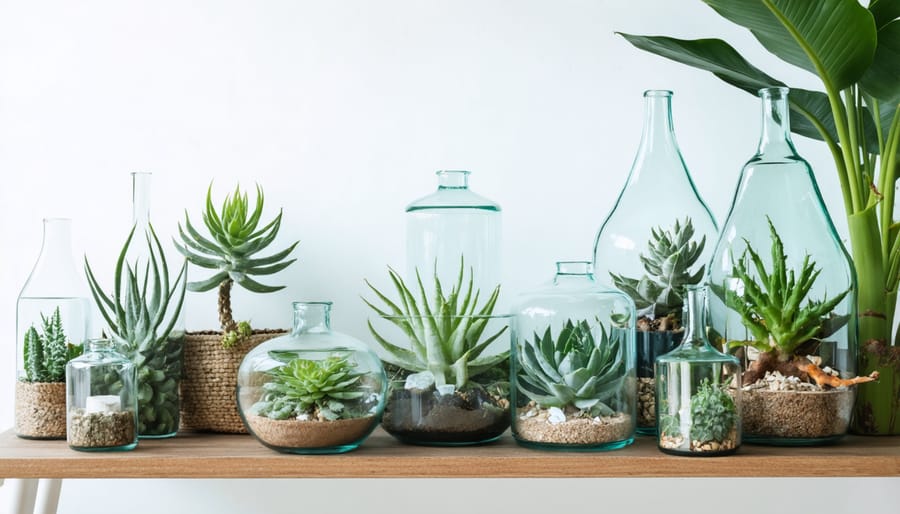Transform your living space into a sanctuary of emotional well-being by incorporating biophilic design principles that tap into our innate psychological connections with nature. The human mind responds instinctively to natural elements, creating profound emotional bonds that can significantly impact our daily lives and mental health. Research shows that spaces designed with natural connections can reduce stress levels by up to 60% and increase creativity by 15%, making the integration of nature-inspired elements more than just an aesthetic choice—it’s a scientific approach to emotional well-being.
By understanding these psychological connections, we can intentionally create environments that nurture our mental health, boost productivity, and enhance our overall quality of life. Whether through the strategic placement of indoor plants, the use of natural materials, or the incorporation of organic patterns and textures, every design choice has the potential to strengthen our connection to nature and deepen our emotional resonance with our surroundings.
The Science Behind Nature’s Emotional Impact
Our Innate Connection to Nature
Have you ever noticed how a walk in the park instantly lifts your mood, or how the sight of flowers blooming makes you smile? This natural response isn’t just coincidence – it’s hardwired into our DNA. Scientists call this innate attraction to nature the “biophilia hypothesis,” which suggests that humans have an inherent need to connect with nature and other living systems.
Our ancestors spent thousands of generations living in close contact with the natural world, learning to read its patterns and respond to its rhythms. This deep evolutionary history has left an indelible mark on our psychology, influencing everything from our stress responses to our aesthetic preferences.
When we experience natural elements – whether it’s sunlight streaming through windows, the gentle sound of flowing water, or the presence of plants – our bodies respond positively. Studies show that exposure to nature can lower blood pressure, reduce stress hormones, and improve concentration. Even simple natural patterns, like the spiral of a shell or the veining of a leaf, can trigger these beneficial responses.
This biological connection explains why incorporating nature into our living spaces feels so right – it’s not just about aesthetics, it’s about honoring our fundamental human nature.

The Stress-Reducing Power of Natural Elements
Research consistently shows that incorporating natural elements into our living spaces can significantly reduce stress levels and improve overall well-being. Studies have found that simply viewing natural scenes or having indoor plants can lower blood pressure, decrease anxiety, and boost mood within minutes.
The presence of natural light, for instance, helps regulate our circadian rhythm, leading to better sleep patterns and reduced stress hormones. Water features, like small fountains or aquariums, create calming white noise that can lower cortisol levels and promote relaxation. Even the subtle patterns found in wood grain or stone textures can trigger a subconscious sense of calm and groundedness.
Natural materials also improve indoor air quality, with certain plants acting as natural air purifiers. This cleaner air contributes to better cognitive function and reduced mental fatigue. The gentle movement of leaves, the play of natural light, and organic textures all work together to create a multi-sensory experience that our brains instinctively recognize as safe and nurturing.
These stress-reducing benefits aren’t just temporary – regular exposure to natural elements in our homes can lead to lasting improvements in mental health and emotional resilience.
Creating Emotional Bonds Through Design

Natural Light and Emotional Well-being
Natural light plays a pivotal role in shaping our emotional well-being and mental health. Understanding the benefits of natural light can help you create spaces that nurture psychological wellness.
To maximize natural light in your home, start by keeping windows clean and unobstructed. Consider removing heavy drapes and replacing them with sheer curtains that filter light while maintaining privacy. Strategic mirror placement can help bounce light deeper into rooms, creating brighter, more uplifting spaces.
Arrange your furniture to take advantage of natural light patterns throughout the day. Position frequently used areas, like reading nooks or work spaces, near windows. If possible, create multi-purpose rooms that can adapt to different activities based on natural light availability.
Color choices also impact light reflection. Opt for light, neutral wall colors to amplify natural brightness. Consider glass doors or transom windows to allow light flow between rooms. For spaces with limited natural light, consider installing solar tubes or skylights to bring in overhead illumination.
Remember to create contrast zones too. While maximizing natural light is beneficial, having some areas with filtered or softer light provides visual comfort and emotional balance. This variety in lighting helps maintain our natural circadian rhythms and supports overall psychological well-being.
Living Elements That Spark Joy
The natural world has a profound impact on our emotional well-being, and bringing living elements into our homes creates powerful psychological connections. Plants, in particular, serve as more than just decorative elements – they become living companions that respond to our care and attention. The art of styling indoor plants can transform any space into a nurturing environment that promotes mental wellness and emotional balance.
Natural materials like wood, stone, and bamboo complement living greenery by adding layers of organic texture and warmth. These elements work together to create a multi-sensory experience that grounds us in the present moment. The gentle rustle of leaves, the subtle fragrance of herbs, and the varied textures of natural materials all contribute to a space that feels alive and dynamic.
Consider incorporating different plant varieties that resonate with your emotional needs. Calming lavender can help create a peaceful bedroom sanctuary, while energizing citrus plants might be perfect for a home office. Snake plants and peace lilies not only purify the air but also add striking vertical elements that draw the eye upward, creating a sense of space and possibility.
Remember that caring for living elements isn’t just about maintenance – it’s about building a relationship with your environment. This daily interaction becomes a mindful practice that can reduce stress and increase your connection to the natural world, even within urban settings.
Nature-Inspired Colors and Patterns
Nature has perfected its color palette over millions of years, and there’s a reason we feel at peace when surrounded by natural hues and patterns. Understanding color psychology in design helps us recreate these calming effects in our homes.
Soft greens reminiscent of forest canopies can lower stress levels and promote healing, while earth tones like warm browns and sandy beiges help ground us and create a sense of stability. Ocean blues and sky-inspired colors encourage relaxation and clear thinking, making them perfect for bedrooms and home offices.
Natural patterns follow organic, flowing forms rather than rigid geometric shapes. Consider incorporating leaf motifs, wave-like curves, or spiral patterns that mirror what we see in nature. These elements can be introduced through wallpaper, textiles, or decorative accessories without overwhelming the space.
When selecting materials and textures, opt for those that echo natural elements: wood grain patterns, stone-like surfaces, or fabric prints inspired by botanical forms. The key is to create subtle layers that work together harmoniously, just as they do in nature. Start with a foundation of neutral, nature-inspired colors, then add depth through patterns and textures that feel authentic and unforced.
Remember that natural light plays a crucial role in how these colors and patterns are perceived, so position your nature-inspired elements where they can best interact with daylight for maximum impact.
Practical Implementation Strategies
Room-by-Room Biophilic Solutions
Transform each room in your home into a nurturing space that strengthens your connection with nature. In the living room, position seating to face natural views and incorporate tactile natural materials like wooden coffee tables or stone decorative pieces. Add scattered cushions with nature-inspired patterns and textures to create comfortable conversation areas that encourage social bonding.
For the bedroom, focus on creating a serene sanctuary using earthy color palettes and organic bedding materials. Place plants that purify air, like snake plants or peace lilies, in corners where they’re visible from your bed. Consider installing nature-sound machines or water features to enhance relaxation and sleep quality.
Kitchen spaces benefit from herb gardens that combine functionality with biophilic elements. Position these near windows to maximize natural light and create a direct connection to food sources. Use wooden cutting boards and natural stone countertops to incorporate tactile natural elements into daily cooking routines.
In home offices, arrange your desk to face windows when possible, allowing natural light to regulate your circadian rhythm. Include small water features or nature sounds to mask distracting noise and promote focus. Choose artwork depicting natural scenes for walls you face while working.
Bathrooms can become spa-like retreats with the addition of moisture-loving plants, natural stone tiles, and wooden bath mats. Consider installing a rainfall shower head to mimic natural precipitation and adding nature-inspired scents through essential oils.
Remember to maintain consistency in natural elements throughout your home while adapting solutions to each room’s specific function and atmosphere. This creates a cohesive flow that strengthens the psychological benefits of biophilic design.

Budget-Friendly Natural Elements
Creating a nature-inspired space doesn’t have to break the bank. Start with the most accessible natural element: light. Position mirrors strategically to reflect natural daylight and create the illusion of bringing more outdoors inside. Consider adding sheer curtains that allow light to filter through while creating a gentle, dappled effect.
Plants are another budget-friendly way to incorporate natural elements. Start with easy-care varieties like pothos, snake plants, or ZZ plants, which are both affordable and resilient. Propagate your existing plants to multiply your green friends without spending extra money. Display found natural objects like pinecones, interesting branches, or smooth river rocks in glass jars or bowls for instant natural charm.
Natural textures can be introduced through affordable materials like jute rugs, bamboo blinds, or cotton throws with organic patterns. Shop second-hand stores for wooden furniture pieces that can be restored or repurposed. Create your own nature-inspired artwork using pressed leaves or flowers in simple frames.
Color is a powerful tool that’s incredibly budget-friendly. Paint an accent wall in earth tones or forest greens to evoke nature. Use removable wallpaper with botanical prints for a temporary solution that makes a big impact. Consider bringing in natural patterns through affordable throw pillows or area rugs featuring leaf, flower, or geometric patterns inspired by nature.
DIY projects can add natural elements without significant expense. Create a vertical garden using recycled materials, craft a driftwood wall hanging, or make your own botanical prints using leaves and craft paint. Remember, nature-inspired design is about creating connections, not perfection – sometimes the simplest elements can have the strongest impact on our psychological well-being.
Maintaining Your Natural Connection
Maintaining your natural connections doesn’t have to be complicated or time-consuming. Start by establishing a regular care routine for your indoor plants – think of it as nurturing your emotional investment. Set reminders for watering, pruning, and cleaning leaves, making these moments an opportunity for mindful connection with nature.
Keep your natural materials looking their best by dusting wooden surfaces regularly and treating them with appropriate oils or conditioners every few months. For stone elements, use gentle, pH-neutral cleaners to preserve their natural beauty while protecting their surface.
Natural light is precious, so make it a habit to clean your windows regularly and adjust your curtains or blinds throughout the day to maximize daylight exposure. Consider rotating your plants seasonally to ensure they receive optimal light and maintain their vitality.
Pay attention to your sensory elements too. Refresh natural scents periodically, whether through essential oils or fresh herbs. Replace dried flowers and branches when they lose their vibrancy, and regularly clean or replace natural fiber textiles to maintain their tactile appeal.
Most importantly, take time to actively engage with your biophilic elements daily. Touch the leaves of your plants, breathe in natural scents, and pause to observe how sunlight plays across natural textures. These small moments of connection help reinforce the psychological benefits of your nature-inspired space while ensuring your design elements continue to thrive and evolve with you.
The journey to creating psychological connections through biophilic design is both rewarding and transformative. By incorporating natural elements into our living spaces, we not only enhance the aesthetic appeal of our homes but also forge deeper emotional bonds with our environment. The research is clear: spaces that embrace nature contribute significantly to our mental well-being, reduce stress, and improve our overall quality of life.
Remember that your biophilic journey doesn’t have to be overwhelming. Start small with a few houseplants, natural materials, or a water feature. Pay attention to how these changes affect your mood and energy levels. Notice how natural light transforms your space throughout the day, or how the gentle sound of flowing water helps you unwind after a long day.
The key is to create meaningful connections that resonate with your personal preferences and lifestyle. Whether it’s through tactile experiences with natural textures, visual connections with outdoor views, or the calming presence of indoor gardens, each element plays a vital role in strengthening your relationship with nature.
Take the first step today. Choose one area of your home and begin introducing natural elements that speak to you. As you progress, you’ll discover that biophilic design is more than just a design trend – it’s a pathway to creating spaces that nurture both body and soul, supporting your well-being for years to come.
